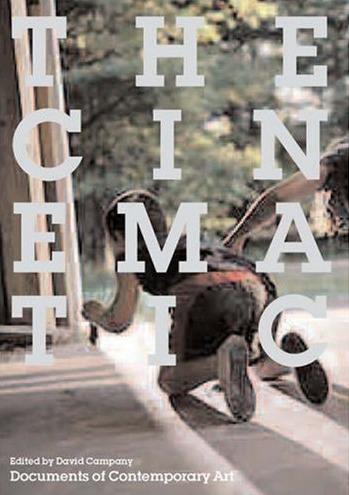David Campany (ed.): The Cinematic (2007)
Filed under book | Tags: · art history, cinema, contemporary art, film, film history, photography, video art

“The cinematic has been a springboard for the work of many influential artists, including Victor Burgin, Philip-Lorca diCorcia, Stan Douglas, Nan Goldin, Douglas Gordon, Cindy Sherman, and Jeff Wall, among others. Much recent cinema, meanwhile, is rich with references to contemporary photography. Video art has taken a photographic turn into pensive slowness; photography now has at its disposal the budgets and scale of cinema. This addition to Whitechapel’s Documents of Contemporary Art series surveys the rich history of creative interaction between the moving and the still photograph, tracing their ever-changing relationship since early modernism.
Still photography—cinema’s ghostly parent—was eclipsed by the medium of film, but also set free. The rise of cinema obliged photography to make a virtue of its own stillness. Film, on the other hand, envied the simplicity, the lightness, and the precision of photography. Russian Constructivist filmmakers considered avant-garde cinema as a sequence of graphic “shots”; their Bauhaus, Constructivist and Futurist photographer contemporaries assembled photographs into a form of cinema on the page. In response to the rise of popular cinema, Henri Cartier-Bresson exalted the “decisive moment” of the still photograph. In the 1950s, reportage photography began to explore the possibility of snatching filmic fragments. Since the 1960s, conceptual and postconceptual artists have explored the narrative enigmas of the found film still. The Cinematic assembles key writings by artists and theorists from the 1920s on—including László Moholy-Nagy, Pier Paolo Pasolini, Victor Burgin, Jeff Wall, and Catherine David—documenting the photography-film dialogue that has enriched both media.”
Contributors:
Roland Barthes, Jean Baudrillard, Raymond Bellour, Anton Giulio Bragaglia, Victor Burgin, Henri Cartier-Bresson, Catherine David, Thierry de Duve, Gilles Deleuze, Philip-Lorca diCorcia, Philippe Dubois, Régis Durand, Sergei Eisenstein, Mike Figgis, Hollis Frampton, Susanne Gaensheimer, Nan Goldin, Chris Marker, Christian Metz, Laura Mulvey, László Moholy-Nagy, Beaumont Newhall, Uriel Orlow, Pier Paolo Pasolini, Constance Penley, Richard Prince, Steve Reich, Carlo Rim, Raul Ruiz, Susan Sontag, Blake Stimson, Michael Tarantino, Agnès Varda, Jeff Wall, Andy Warhol, and Peter Wollen.
Publisher Whitechapel Art Gallery, London, 2007
Documents of Contemporary Art series
ISBN 0854881522, 9780854881529
221 pages
PDF (updated on 2022-11-29)
Comments (2)Rich Gold: The Plenitude: Creativity, Innovation, and Making Stuff (2007)
Filed under book | Tags: · art, design, science, technology, ubiquitous computing

We live with a lot of stuff. The average kitchen, for example, is home to stuff galore, and every appliance, every utensil, every thing, is compound—composed of tens, hundreds, even thousands of other things. Although each piece of stuff satisfies some desire, it also creates the need for even more stuff: cereal demands a spoon; a television demands a remote. Rich Gold calls this dense, knotted ecology of human-made stuff the “Plenitude.” And in this book—at once cartoon treatise, autobiographical reflection, and practical essay in moral philosophy—he tells us how to understand and live with it.
Gold writes about the Plenitude from the seemingly contradictory (but in his view, complementary) perspectives of artist, scientist, designer, and engineer—all professions pursued by him, sometimes simultaneously, in the course of his career. “I have spent my life making more stuff for the Plenitude,” he writes, acknowledging that the Plenitude grows not only because it creates a desire for more of itself but also because it is extraordinary and pleasurable to create.
Gold illustrates these creative expressions with witty cartoons. He describes “seven patterns of innovation”—including “The Big Kahuna,” “Colonization” (which is illustrated by a drawing of “The real history of baseball,” beginning with “Play for free in the backyard” and ending with “Pay to play interactive baseball at home”), and “Stuff Desires to Be Better Stuff” (and its corollary, “Technology Desires to Be Product”). Finally, he meditates on the Plenitude itself and its moral contradictions. How can we in good conscience accept the pleasures of creating stuff that only creates the need for more stuff? He quotes a friend: “We should be careful to make the world we actually want to live in.”
Publisher MIT Press, 2007
Simplicity: Design, Technology, Business, Life series
ISBN 0262072890, 9780262072892
111 pages
PDF (updated on 2012-11-19)
Comment (0)Yochai Benkler: A Free Irresponsible Press: Wikileaks and the Battle Over the Soul of the Networked Fourth Estate (draft, 2011)
Filed under paper | Tags: · internet, journalism, mass media, network culture, networks, politics, wikileaks
A study of the events surrounding the Wikileaks document releases in 2010 provides a rich set of insights about the weaknesses and sources of resilience of the emerging networked fourth estate. It marks the emergence of a new model of watchdog function, one that is neither purely networked nor purely traditional, but is rather a mutualistic interaction between the two. It identifies the peculiar risks to, and sources of resilience of, the networked fourth estate in a multidimensional system of expression and restraint, and suggests the need to resolve a major potential vulnerability—the extralegal cooperation between the government and private infrastructure companies to restrict speech without being bound by the constraints of legality. Finally, it offers a richly detailed event study of the complexity of the emerging networked fourth estate, and the interaction, both constructive and destructive, between the surviving elements of the traditional model and the emerging elements of the new. It teaches us that the traditional, managerial-professional sources of responsibility in a free press function imperfectly under present market conditions, while the distributed models of mutual criticism and universal skeptical reading, so typical of the Net, are far from powerless to deliver effective criticism and self-correction where necessary. The future likely is, as the Guardian described its own experience with Wikileaks, “a new model of co-operation,” between surviving elements of the traditional, mass-mediated fourth estate, and its emerging networked models. The transition to this new model will likely be anything but smooth.
Working Paper of article forthcoming in the Harvard Civil Rights – Civil Liberties Law Review.
8 February 2011 version.
66 pages
PDF
Update: PDF (current version)

